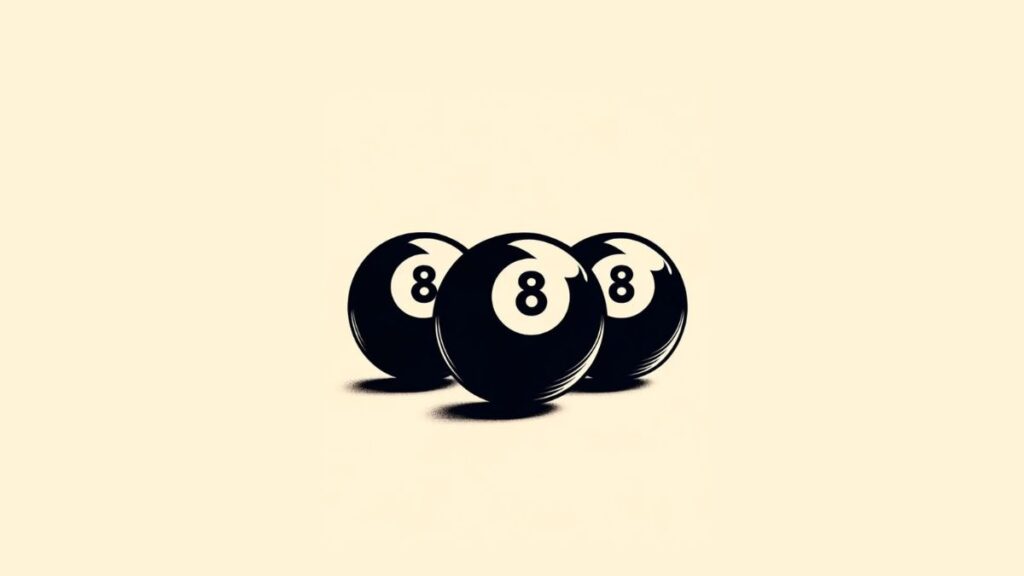Few objects in modern culture carry as much layered meaning as the humble 8 ball. At first glance, it’s simply a black sphere with a white number eight, one of the standard balls used in the game of pool. But dig deeper, and you’ll find that the significance of the 8 ball stretches far beyond the green felt of a billiards table. It has become a symbol in music, film, fashion, and even spiritual practices. From its practical role in cue sports to its metaphorical weight in everyday language, the 8 ball occupies a unique space in our collective imagination.
This article explores the multifaceted significance of the 8 ball, tracing its origins in the world of billiards, examining its symbolic interpretations, and unpacking its cultural resonance across decades. Whether you’re a casual observer or a dedicated enthusiast, understanding the significance of the 8 ball offers insight into how a simple game piece can evolve into a powerful cultural icon.
Origins in Billiards: The Practical Role of the 8 Ball
To understand the broader significance of the 8 ball, we must begin with its birthplace: the game of pool. Billiards, in its various forms, has been played for centuries, but the modern version of eight-ball pool emerged in the United States during the early 20th century. The game quickly gained popularity in bars, pool halls, and community centers due to its straightforward rules and competitive nature.
In eight-ball pool, 15 object balls are used—seven solid-colored balls (numbered 1 through 7), seven striped balls (9 through 15), and the solid black 8 ball. Players are assigned either solids or stripes after the break, and the objective is to pocket all of their designated balls before legally sinking the 8 ball. Crucially, if a player sinks the 8 ball prematurely or commits a foul while attempting to do so, they lose the game.
This pivotal role gives the 8 ball immense weight within the game. It’s not just another ball—it’s the final challenge, the ultimate test of skill and strategy. Because the game literally ends with the 8 ball, it carries a sense of finality and consequence. One wrong move, and victory slips away. This high-stakes function laid the groundwork for the deeper significance of the 8 ball in broader contexts.
Symbolism and Superstition: Why the 8 Ball Stands Out
Beyond its role in gameplay, the 8 ball has accrued layers of symbolism. Its stark black color and central number make it visually distinct, which naturally invites interpretation. In many cultures, the number 8 itself is considered auspicious. In Chinese tradition, for example, the number 8 symbolizes prosperity and good fortune because its pronunciation sounds similar to the word for “wealth.” Conversely, in Western contexts, black often represents mystery, power, or even danger—qualities that align with the 8 ball’s decisive role in pool.
The duality of the 8 ball—its potential to bring either triumph or defeat—has made it a symbol of fate and uncertainty. This idea is reinforced by its resemblance to another famous “8 ball”: the Magic 8 Ball, a toy used for fortune-telling. Though unrelated in origin (the Magic 8 Ball was invented in the 1940s as a novelty item), the visual similarity strengthens the association between the pool 8 ball and themes of destiny, chance, and hidden knowledge.
Players and spectators alike have developed superstitions around the 8 ball. Some believe that touching it before your turn brings bad luck; others avoid saying its name aloud during a match. These rituals, while not part of official rules, reflect how deeply the significance of the 8 ball is embedded in the psychology of the game.
The Magic 8 Ball: A Parallel Cultural Phenomenon
While the pool 8 ball governs the outcome of a physical game, the Magic 8 Ball offers answers to life’s uncertainties. Invented by Albert C. Carter and later refined by Abe Bookman, the Magic 8 Ball was inspired by a spirit board Carter’s mother used as a clairvoyant. Marketed by Mattel since the 1970s, it contains a 20-sided die floating in blue liquid, with each face displaying a different response—ranging from “Yes” to “Outlook not so good.”
Though technically a different object, the Magic 8 Ball borrows its name and appearance from the pool ball, capitalizing on its cultural familiarity. This crossover has blurred the lines between the two in the public imagination. When people refer to an “8 ball” in a non-sports context, they might be thinking of the fortune-telling toy rather than the cue ball.
This duality enhances the significance of the 8 ball as a symbol of decision-making and fate. Whether on a pool table or held in your hands for guidance, the 8 ball represents a moment of truth—a point where choices converge and outcomes are revealed. Its presence in both recreational and mystical contexts underscores its versatility as a cultural symbol.
The 8 Ball in Music and Pop Culture
Few symbols have permeated popular culture as thoroughly as the 8 ball. In music—particularly hip-hop, rock, and blues—the 8 ball frequently appears as a metaphor for risk, rebellion, or streetwise wisdom. Rappers like Nas, Jay-Z, and Biggie have referenced the 8 ball in lyrics to signify high-stakes decisions or the unpredictability of life. For example, in Nas’s classic track “The World Is Yours,” he raps, “Life is a gamble, roll the dice, 8 ball,” directly linking the object to themes of chance and survival.
In rock music, the band AC/DC released an album titled Ballbreaker featuring an 8 ball on the cover, reinforcing its association with danger and intensity. Meanwhile, the 1980s saw the rise of “8-ball” jackets—colorful, quilted coats adorned with large 8 ball patches—popularized by urban youth and later embraced by celebrities like Run-D.M.C. and Michael Jackson. These jackets turned the 8 ball into a fashion statement, symbolizing coolness, confidence, and a touch of rebellion.
Film and television have also capitalized on the significance of the 8 ball. Movies like The Hustler (1961) and Poolhall Junkies (2002) use the 8 ball as a narrative device to heighten tension during climactic scenes. In The Simpsons, Bart Simpson once uses a Magic 8 Ball to make life decisions, humorously highlighting society’s reliance on external validation. Even video games, from Grand Theft Auto to Tony Hawk’s Pro Skater, include 8 balls as collectibles or visual motifs, further cementing their place in digital culture.
The 8 Ball as a Metaphor in Everyday Language
Language evolves with culture, and the 8 ball has found its way into common idioms and expressions. Phrases like “behind the 8 ball” originate from pool, where being “behind the 8 ball” means your cue ball is blocked by the 8 ball, making your next shot extremely difficult. Over time, this phrase has entered everyday speech to describe being in a tough or disadvantageous situation—financially, emotionally, or otherwise.
Similarly, “playing with the 8 ball” can imply taking unnecessary risks or dealing with volatile circumstances. These expressions demonstrate how the significance of the 8 ball has transcended its physical form to become a linguistic shorthand for complexity, danger, and consequence.
Even outside of direct references, the shape and color of the 8 ball evoke instant recognition. Designers, advertisers, and artists often use its silhouette to convey ideas of mystery, finality, or hidden potential. A black circle with a white number isn’t just a game piece—it’s a visual cue loaded with meaning.
Controversies and Misinterpretations
Despite its widespread appeal, the 8 ball hasn’t always enjoyed a positive reputation. In some contexts, particularly in the late 20th century, the term “8 ball” was co-opted as slang for a specific quantity of illicit drugs—usually one-eighth of an ounce of cocaine or other substances. This usage, while geographically and temporally limited, has led to occasional misunderstandings or negative associations.
It’s important to distinguish this slang from the original and predominant meanings tied to billiards and pop culture. Most references to the 8 ball—especially in mainstream media—have nothing to do with drug culture. Nevertheless, this alternate meaning serves as a reminder of how symbols can be repurposed, sometimes in ways that obscure their original significance of the 8 ball.
Educators, historians, and cultural commentators often emphasize the need to reclaim and clarify the 8 ball’s legacy, focusing on its roots in sport, entertainment, and human psychology rather than its brief and niche association with underground slang.
Psychological and Philosophical Dimensions
On a deeper level, the significance of the 8 ball speaks to fundamental human experiences: uncertainty, choice, and consequence. In philosophy, the concept of determinism—the idea that all events are predetermined—contrasts with free will. The 8 ball, in both its pool and Magic forms, sits at this intersection. In pool, your success depends on skill, strategy, and sometimes luck; in the Magic 8 Ball, answers appear random yet feel strangely personal.
Psychologists might interpret our fascination with the 8 ball as a manifestation of our desire for control in an unpredictable world. When faced with difficult decisions, people often seek external tools—horoscopes, tarot cards, or yes, Magic 8 Balls—to reduce anxiety. The 8 ball becomes a proxy for clarity, even if its answers are ultimately arbitrary.
Moreover, the game of eight-ball itself mirrors life’s structure: you’re given a set of challenges (your assigned balls), must navigate obstacles (your opponent, the table layout), and face a final, decisive moment (the 8 ball shot). This narrative arc resonates because it reflects our own journeys—full of preparation, setbacks, and culminating choices.
Thus, the significance of the 8 ball extends into the realm of existential reflection. It’s not just a toy or a sports accessory; it’s a mirror for how we confront uncertainty and define success.
Global Perspectives on the 8 Ball
While the 8 ball originated in American pool culture, its influence is now global. In countries where billiards is less common, the Magic 8 Ball often serves as the primary reference point. japan, for instance, the Magic 8 Ball has been marketed as a quirky Western novelty, sometimes appearing in anime and manga as a symbol of Western mysticism or teenage curiosity.
In Europe, pool halls have long embraced eight-ball as a standard game, and the 8 ball retains its role as the game-ending object. However, European players might be less familiar with the slang or fashion trends surrounding the 8 ball in the U.S., showing how cultural context shapes interpretation.
Interestingly, the number 8 itself holds positive connotations in many Asian cultures, as mentioned earlier. This adds another layer to the significance of the 8 ball in international markets—where its black color might be seen not as ominous, but as elegant or powerful, especially when paired with the lucky number 8.
These global variations demonstrate that while the physical object remains the same, its meaning is fluid, shaped by local beliefs, traditions, and media exposure.
The 8 Ball in Modern Media and Digital Culture
In the age of the internet, the 8 ball continues to evolve. Memes featuring the Magic 8 Ball offering absurd or ironic answers circulate widely on social media, often used to mock indecisiveness or highlight life’s absurdities. GIFs of pool players dramatically sinking the 8 ball underscore moments of triumph or irony in online conversations.
Digital games have also embraced the 8 ball. Mobile apps like 8 Ball Pool by Miniclip boast millions of players worldwide, introducing a new generation to the rules and tension of the game. In these virtual spaces, the significance of the 8 ball remains intact—it’s still the final, decisive shot that determines victory or defeat.
Moreover, NFTs and digital art have featured stylized 8 balls as collectibles, blending nostalgia with cutting-edge technology. Artists reinterpret the classic design with neon colors, glitch effects, or surreal backgrounds, proving that the 8 ball’s visual power endures even in abstract forms.
This digital renaissance ensures that the significance of the 8 ball will continue to grow, adapting to new platforms while retaining its core associations with fate, skill, and finality.
Conclusion: Why the 8 Ball Endures
From its humble beginnings on the pool table to its status as a global cultural icon, the significance of the 8 ball is both profound and multifaceted. It represents the climax of a game, the weight of a decision, and the mystery of the unknown. Whether as a literal object in sports, a toy offering cryptic advice, or a metaphor in everyday speech, the 8 ball captures something essential about the human condition: our constant negotiation between control and chance.
Its visual simplicity—black sphere, white number—makes it instantly recognizable, while its contextual flexibility allows it to mean different things to different people. A pool player sees a challenge; a teenager sees a fun toy; a lyricist sees a symbol of street life; a philosopher sees a question about fate.
As long as people play games, seek answers, and navigate uncertain paths, the significance of the 8 ball will remain relevant. It’s more than just a ball—it’s a cultural touchstone, a psychological mirror, and a timeless symbol of life’s pivotal moments. And in a world full of complexity, there’s something reassuring about the clarity of an 8 ball: sink it cleanly, and you win. Miss it, and you lose. In that stark binary, we find both tension and truth.
Ultimately, the enduring significance of the 8 ball lies in its ability to unite play, symbolism, and human experience in one deceptively simple object. As we continue to roll through life’s unpredictable tables, the 8 ball reminds us that every shot matters—and that the final one carries the most weight of all.







